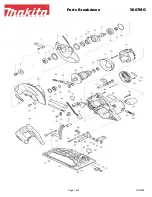
5
3.
Place a good quality, 10 inch (254.0 mm) master
square on the worktable against the post's back side.
Measure clearance between the post and square
near the bottom of the post. Clearance should be
within 0.007-inch
±
0.005-inch (0.18 mm
±
0.13 mm)
at the bottom of the post for standard machines.
4.
Add or remove shims under the base pads until the
correct post to square clearance is obtained.
The machine must be bolted to the floor for
worktable loads over 100 pounds (5. kg).
ELECTRICAL INSTALLATION
Electrcal nstallaton must be made by
authorzed electrcal mantenance personnel
only!
1.
Refer to the machine specifications plate on the
machine frame to verify that the electrical supply
circuit will meet the voltage/phase/frequency/
amperage requirements listed. A basic data plate
is reproduced on this manual’s introductory page.
2.
Bring the incoming power leads into the machine's
electrical box. Refer to the electrical schematic and
the parts manual, if necessary, when making the
connections.
3.
Turn the disconnect switch on the electrical box
to "ON". Then:
(a)
Alternately jog the
Band
Start
and
All Stop
pushbuttons;
(b)
Check to make sure
the saw band is running in a
clockwse
motion:
(c)
Reverse the leads if saw band movement is
incorrect.
PREPARATION FOR USE
1.
Check the transmission oil level. Capacity is 1
quart (0.95 liters). If the reservoir level is low (or
empty):
(a)
Check to see that the transmission plug
is installed tightly;
(b)
See the
"Maintenance"
section
for proper procedure of checking and/or filling the
transmission.
(c)
Refer to the Lubrication Chart later
in this manual for recommended lubricants.
2.
Shop air is required to operate the optional chip
blower, mist coolant, sliding air table and/or band
lubricator. Incoming air supply should be between
80 and 90 psi (5.5 and 6.2 bar or 5.6 and 6.3 kg/
cm²).
DO NOT exceed 90 ps (6.2 bar or 6.3 kg/
cm²).
MACHINE INSTALLATION and ALIGNMENT
(Continued....)
3.
Check the band mist lubricator unit (if supplied) for
the proper reservoir level. Refer to the manufacturer
supplied literature for reservoir capacity and
recommended procedures.
4.
Make sure all other points listed by the Lubrication
Chart have been properly serviced.










































